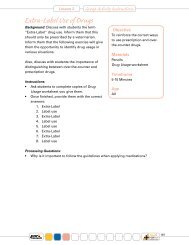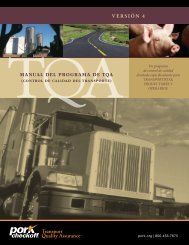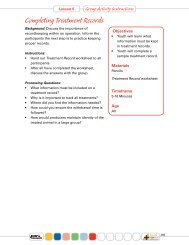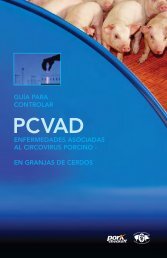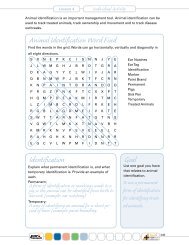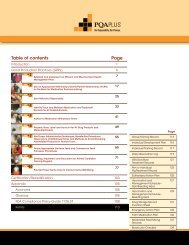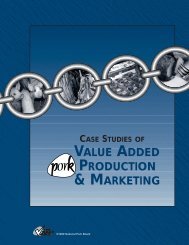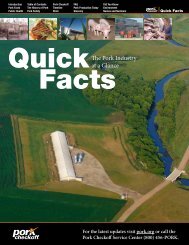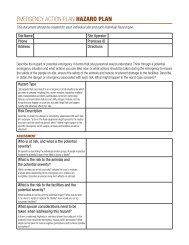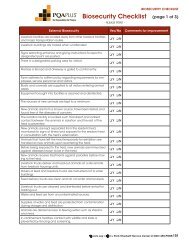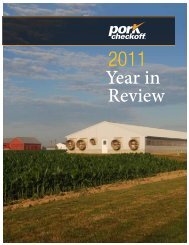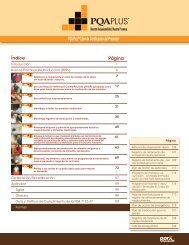PRRS Compendium Producer Edition - National Pork Board
PRRS Compendium Producer Edition - National Pork Board
PRRS Compendium Producer Edition - National Pork Board
Create successful ePaper yourself
Turn your PDF publications into a flip-book with our unique Google optimized e-Paper software.
Table 3 for low, moderate,<br />
and high impact<br />
scenarios. The baseline<br />
assumptions for these<br />
analyses included an<br />
incoming pig weight<br />
of 50 pounds, 130 days<br />
on feed, 1.6 pounds of<br />
gain per day, and a feed<br />
efficiency of 3.0. The<br />
low impact scenario<br />
assumes a 3% improvement<br />
in marketability (an<br />
increase from 85-88%<br />
associated with a reduction<br />
in mortality from 5<br />
to 4% and a reduction in<br />
culls from 10 to 8%) and a<br />
0.05 improvement in ADG<br />
and F/G. The moderate<br />
impact scenario assumes<br />
an improvement of 5%<br />
marketability (an increase<br />
from 85 to 90% associated<br />
with a reduction in mortality<br />
from 5 to 3% and a reduction<br />
in culls from 10 to<br />
7%), 0.1 ADG, and 0.1 F/G.<br />
And the high impact scenario<br />
and assumes a 10%<br />
Breeding herd Growing pig herd Transmission Intervention objective<br />
Positive 1 , Unstable 2 Positive, Unstable<br />
Vertical and<br />
horizontal<br />
Positive, Stable 3 Positive, Unstable Horizontal<br />
Positive, Stable Negative None<br />
Stabilize breeding<br />
herd<br />
Stabilize growing pig<br />
herd<br />
Eliminate virus in<br />
breeding herd<br />
Negative 4 Negative None Prevention<br />
Table 4: Classification of herds based upon <strong>PRRS</strong> virus transmission. 1 Are now and/or<br />
have been previously infected with <strong>PRRS</strong> virus; Unstable denotes virus is circulating<br />
within and/or among production stages (e.g., among sows, and/or between sows and<br />
pigs); Stable denotes virus is not circulating within and/or among production stages;<br />
4 Not infected with <strong>PRRS</strong> virus<br />
Sow<br />
inventory<br />
Pig<br />
inventory<br />
# pig<br />
flows<br />
# samples<br />
Cost of<br />
serology<br />
Cost / sow Cost / pig<br />
250 2500 1 720 $ 3600 $14.40 $ 0.720<br />
500 5000 1 720 $ 3600 $ 7.20 $ 0.360<br />
1000 10000 1 720 $ 3600 $ 3.60 $ 0.180<br />
2500 25000 1 720 $ 3600 $ 1.44 $ 0.072<br />
2500 25000 2 1080 $ 5400 $ 2.16 $ 0.108<br />
5000 50000 1 720 $ 3600 $ 0.72 $ 0.036<br />
5000 50000 2 1080 $ 5400 $ 1.08 $ 0.054<br />
5000 50000 4 1800 $ 9000 $ 1.80 $ 0.090<br />
Table : Annual cost of transmission profiling based upon herd size<br />
improvement in marketability (an increase from 80 to 90% associated with a reduction in mortality from 7<br />
to 4% and a reduction in culls from 13 to 6%) and a 0.15 improvement in ADG and F/G.<br />
The Financial Impact of <strong>PRRS</strong> Intervention: The importance and cost of the proper diagnosis<br />
<strong>PRRS</strong> is often blamed for performance problems that either are not caused by <strong>PRRS</strong> virus or are not due<br />
to <strong>PRRS</strong> virus alone. In breeding herds, when farrowing rates or litter size fall below expectations, <strong>PRRS</strong><br />
is frequently held accountable. In the growing pig, <strong>PRRS</strong> virus is often considered responsible for respiratory<br />
disease and poor performance. Sometimes the blame is justified; all too often, it is not. Many times,<br />
there are infectious and/or management factors which, in addition to <strong>PRRS</strong> (or even instead of <strong>PRRS</strong>), are<br />
deserving of as much or more attention. Although a complete and thorough diagnostic workup may cost<br />
hundreds of dollars, the question must be asked, “What is the cost of not having the proper diagnosis?”<br />
It is not sufficient to determine that a herd is <strong>PRRS</strong> virus positive or negative; nor is it enough to simply<br />
associate clinical problem(s) with <strong>PRRS</strong> virus isolation or antibody seroconversion. Instead, a thorough<br />
diagnostic effort must make the effort to identify other disease-causing agents that may be contributing to<br />
<strong>PRRS</strong>, or perhaps have even been mistaken for it. Due consideration must also be given to the non infectious<br />
factors that often precipitate infectious diseases and even cause the problems that are blamed on<br />
infectious agents. To not do so leads to waste as financial and time resources are invested in useless intervention/prevention<br />
efforts and lost production opportunity, while problems continue to go unresolved.<br />
Once a definitive <strong>PRRS</strong> diagnosis has been made, the first consideration for intervention is to determine<br />
where the circulation of the <strong>PRRS</strong> virus is occurring within a herd. The primary transmission of <strong>PRRS</strong> virus<br />
is pig-to-pig, which can be either vertical (sow-to-piglet) or horizontal (pig-to-pig, sow-to-sow). It is critical<br />
to understand the cycle of transmission within a herd before beginning intervention, especially intervention<br />
in the growing pig herd. If the sow herd is unstable and there is vertical transmission to the growing<br />
pigs, an intervention strategy to eliminate <strong>PRRS</strong> virus in the growing pigs will fail both biologically and<br />
fiscally by not providing a return on investment. On the other hand, if the sow herd is stable (not transmit-<br />
PAGE 4 PIG 04-01-09





